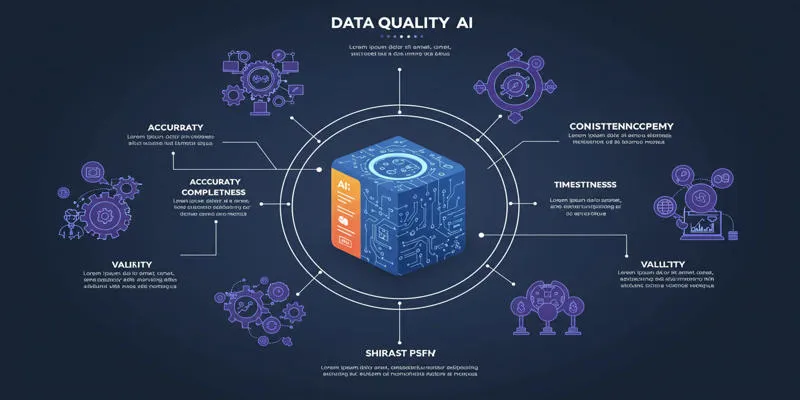The worldwide transformation driven by Artificial Intelligence (AI) relies heavily on obtaining high-quality data for proper operation. The initialization of an AI development project necessitates data that is already prepared. AI systems may fail to detect patterns if the data contains errors and missing values.
Why Data Preparation is Essential for Artificial Intelligence
 Data preparation is
akin to laying a strong foundation for a building. Without a robust
foundation, structures can collapse. Proper data preparation is a prerequisite
for AI models to perform correctly. AI systems require clean, organized, high-
quality data to accelerate learning, improve decision-making, and produce
accurate results.
Data preparation is
akin to laying a strong foundation for a building. Without a robust
foundation, structures can collapse. Proper data preparation is a prerequisite
for AI models to perform correctly. AI systems require clean, organized, high-
quality data to accelerate learning, improve decision-making, and produce
accurate results.
Step 1: Understand the Purpose of Your Data
Before working with your data, establish the reason you need it. Clearly define your data goals by asking two basic questions about your current problem. Identify the necessary type of data. This phase sets the framework for AI applications. Establishing a clear purpose enables you to obtain appropriate data, saving both time and effort.
Step 2: Collect the Right Data
Once you’ve clarified your purpose, the next step is data collection. This involves extracting data from customer feedback, website analytics, sales records, social media comments, and sensors. Gather only the information necessary for your project to avoid complexity during the preparation phase by minimizing excessive or nonessential data acquisition.
Step 3: Check the Quality of Your Data
Not all collected data will be useful. Some may contain errors, missing values, or duplicates. It’s crucial to review your data by checking for missing fields, typing mistakes, repeated entries, or unexpected values. Addressing these issues early improves the reliability of your AI model.
Step 4: Clean the Data
Data cleaning is a vital step. It involves removing duplicate records, handling missing data by filling gaps or removing incomplete records, correcting errors like spelling or formatting issues, and filtering out irrelevant information. Clean data ensures better performance for your AI model.
Step 5: Organize the Data
Organized data is easier for both humans and machines to work with. Use clear, logical naming conventions for rows and columns, group related data coherently, and maintain consistency in formats (e.g., dates or currency). Proper organization enhances data usability and understanding.
Step 6: Label the Data
For many AI projects, especially in supervised learning, data must be labeled. Labeling involves marking data with the correct answer, such as identifying an image as a “cat” or “dog” or labeling emails as “spam” or “not spam.” Accurate labeling is critical as AI learns from these labels.
Step 7: Split the Data
Before training an AI model, divide the data into three sets: the training set (to train the model), the validation set (to assess performance during training), and the test set (to evaluate the model after training). Splitting ensures the model performs well on unseen data.
Step 8: Transform the Data
Raw data often requires transformation to be suitable for AI algorithms. This may include normalizing values, encoding categories into numbers, or creating new features from existing data. Transformation ensures the data is ready for AI models to process effectively.
Step 9: Augment the Data (If Needed)
If the data you have is insufficient, use data augmentation to create more examples. This might involve rotating images, rephrasing text, or other techniques to expand the dataset. Augmentation improves model performance by exposing it to a wider range of scenarios.
Step 10: Validate the Data
Before using the data to train your AI model, perform a final validation. Ensure the data aligns with your project goals, is free of major errors, and maintains a consistent format. Validation is the last step to catch any issues before they impact the AI’s learning process.
Best Practices for Data Preparation
 Proper data
preparation is critical to the success of any AI or machine learning project.
Adhering to best practices ensures that your data is accurate, relevant, and
ready for training. These practices minimize potential errors, reduce biases,
and enhance the overall performance of your model. By focusing on consistency,
quality, and thoroughness, you can create a solid foundation for developing
reliable AI systems.
Proper data
preparation is critical to the success of any AI or machine learning project.
Adhering to best practices ensures that your data is accurate, relevant, and
ready for training. These practices minimize potential errors, reduce biases,
and enhance the overall performance of your model. By focusing on consistency,
quality, and thoroughness, you can create a solid foundation for developing
reliable AI systems.
Keep Detailed Records
Always document every step you take when working with your data. This includes recording the cleaning steps you perform, any transformations applied, and any issues or anomalies you encounter. Detailed documentation ensures that you or your team can easily replicate the process if needed, saving time and avoiding errors. It also helps maintain transparency, which is essential for troubleshooting and improving workflows later.
Stay Consistent
Consistency is key when preparing data. Apply the same rules, formats, and standards across the entire dataset. This means using uniform naming conventions, date formats, and units of measurement, and addressing missing or duplicate data systematically. Inconsistencies can confuse AI models, reduce their accuracy, and compromise the reliability of your results. A well- maintained, consistent dataset lays the foundation for better model performance and insights.
Involve Experts
Whenever possible, bring in domain experts who have in-depth knowledge of the data and its context. These experts can provide valuable insights into what the data represents, identify potential inaccuracies, and guide you in making better decisions when cleaning, labeling, or interpreting the dataset. Their expertise is particularly important for complex or specialized datasets where subtle nuances can make a big difference.
Use Automation
Leverage automation tools to streamline data cleaning, preparation, and transformation tasks. Many software solutions and libraries offer features like identifying duplicates, handling missing values, and standardizing formats. Automation not only saves significant time but also minimizes the risk of human errors during repetitive tasks. By automating tedious processes, you can focus more on analyzing and extracting value from the data.
Common Mistakes to Avoid
- Skipping data cleaning to save time
- Collecting too much irrelevant data
- Ignoring missing values
- Mixing different data formats
- Using unbalanced datasets where one class has much more data than others
Avoiding these mistakes will make your AI project much more successful.
Conclusion
Preparing data for AI development takes time and effort, but it is worth it. Good data preparation makes AI models smarter, faster, and more accurate. By following the steps in this guide — understanding your goal, collecting the right data, cleaning, organizing, labeling, splitting, transforming, and validating — you can set a strong foundation for your AI project. Always remember: better data means better AI results.
 zfn9
zfn9






















